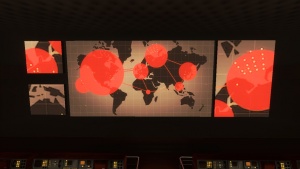Spytech - Design Theme
Introduction
Spytech is a design theme in ![]() Team Fortress 2. This article will go through some noticeable design elements and details found in the spytech areas of TF2 maps.
Team Fortress 2. This article will go through some noticeable design elements and details found in the spytech areas of TF2 maps.
Environment
Location
The spytech theme is best used in interior areas, due to the use of clean textures and equipment props that wouldn't make sense outdoors.
In ctf_2fort this theme is used in the basements of both of the teams forts. In this map it also uses rock walls in addition to the normal walls to enhance the feeling of being underground.
It does however not only need to be used in underground areas. It's mainly used as the inner parts of a team's base, and being behind the "facade" of the structure. In 2fort it happens to be underground because the map layout has basements; however in other maps like cp_gorge it's used at around ground level for the final goal of the map. Whether it be the final control point, the final terminus of a payload map, the team's flag or just anything else is up to the mapper. It doesn't even have to house a vital goal. However, it should still be used behind the facade of the team's base. A secret spy base opened up and exposed to the world isn't really a secret anymore (even if, as the official description of Double Cross admits, nobody is really fooled by the facades).
Textures
The spytech theme uses mostly the concrete/computerwall* textures for walls, and tile/floor_tile_001a through tile/floor_tile_005d for floors. It is also important to use the correct color codings found in these textures to make sure the right color is used in the right base. A red wall in a blue base just doesn't look right.
The world map screens seen in some rooms in the game is a simple brush textured with props/monitor_world_red or props/monitor_world_blue depending on what team it is for. The sides of the brush are usually textured with a gray material, but fancy framing can be done if the mapper wants to do that. The different zooming effects seen on some of the monitors (such as the one in 2fort) are made by simply changing the scale and alignment of the texture.
Architecture
Siderooms

Commonly found in many of the TF2 design themes are inaccessible side rooms. These rooms' purpose is mostly to give the player some insight that the map is more then just an arena to fight and complete objectives. However, these rooms may also serve practical purposes. As seen in the image to the right, they may also be used as light sources.
Wall and ceiling supports
Even though this is one of the cheapest and easiest to make details, it's used heavily throughout this theme to great effect. Wall supports tend to be rounded and use the same texture as the wall behind it. Ceiling beams are usually made of metal, and sometimes have lamps hanging from them.
Models
Models commonly used in this theme are fire extinguishers, intercoms, computer cabinets and various other props that would've been used in a top secret spy base.
Pipes and ventilation drums usually runs along the ceilings.
Computer cabinets
Unique to this theme is the iconic team colored computer cabinets. These are usually made of two prop_statics in the same place with one of them using the model models/props_spytech/computer_wall_cabinet.mdl and the other models/props_spytech/computer_wall*.mdl with it's skin property set to 0 for red, and 1 for blue.
Signs
Many Spytech maps use signs for player navigation.
